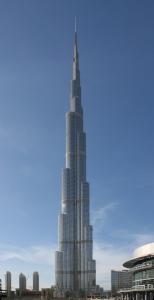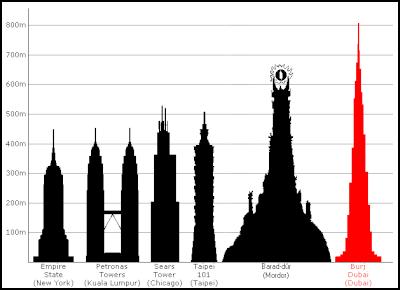Omens of Doom: Dubai’s Burj Khalifa Tower
Omens of Doom: Dubai’s Burj Khalifa Tower
 It is a colossus, towering over
the Dubai skyline. The company behind it claims to have
made a successful return of 10 percent. The local paper,
the Khaleej Times, did not shy away from hyperbole,
seeing the building as ‘an example of human courage and
man’s ability to dream and deliver’, giving the world
‘an achievement difficult to surpass’ (Jan 4).
It is a colossus, towering over
the Dubai skyline. The company behind it claims to have
made a successful return of 10 percent. The local paper,
the Khaleej Times, did not shy away from hyperbole,
seeing the building as ‘an example of human courage and
man’s ability to dream and deliver’, giving the world
‘an achievement difficult to surpass’ (Jan 4).
The Burj Khalifa Tower, renamed in tribute to Dubai’s bailout donor, Abu Dhabi’s Sheik Khalifa, dwarfs all that have come before it. It is a monstrous compilation of gimmicks in some ways, another addition to the mix of Vegas-styled faux islands, shopping centres and ski runs. Dubai portends to be a place of trickery, entertainment and massive expense accounts. The building itself boasts 200 floors, and rises to 828 meters. It promises to be the home of the first Armani Hotel. Patrons are whisked between floors in elevators at the speed of 18 metres a second. But what does this building suggest about Dubai and the architectural madness that characterizes such efforts?
For one thing, the creation strikes deeply at the apocalyptic language of the recently concluded Copenhagen Climate Change conference. The Sheiks seem less interested in carbon footprints than oil-financed structures of glass and steel. They keep company with architects such as Adrian Smith, the designer of the Burj Khalifa and Cesar Pelli, who gave England the One Canada Square and Malaysia the Petronas Twin Towers.
Dubai suffers, like tyrants, from an overwhelming edifice complex. Its spending complex resembles the efforts of the Pharaohs and their pyramid projects, or those of the medieval Catholic Church: bigger is better, huge monuments to progress, humanity and God. Sometimes, the smaller the state, the more obsessed the efforts in building the Tower of Babel. Megalomania is the classic byproduct of inferiority complexes, often induced by money without sense.

Click to enlarge
All of these point to a thesis formulated in 1999 by Andrew Lawrence he dubbed the Skyscraper Index. These figures of modernity seem to precede periods of crisis. At low points of the business cycle, these architectural Cyclops seem to rise. The Empire State building was conceived in 1929, the same year of Black Tuesday (October 29) and the onset of the Great Depression. The Sears Tower of the 1970s towered over a society in the grip of stagflation and oil shocks. The monumental Petronas Twin Towers opened in 1997, the year when Asian currencies took a pummeling, humbling Asia’s ‘Tiger’ economies.
In the civilisational sense, this may also be true: the big building, or building project, is a symptom of decay. The American novelist Henry James certainly thought so, though he was thinking of it more in the aesthetic sense. In an economic sense, the great building project tends to forecast ruin. Athens passed quietly into the shade after the building of the Acropolis. Henry VIII of England and Christian IV of Denmark were builders who drained their treasuries, left magnificent buildings, yet failed consistently on the battlefield. The building efforts of the Pharaohs, as Paul Johnson pointed out in 2005, suggest a hubristic tendency that eventually will meet nemesis. The Wall Street Journal (Jan 5) was confident that such a building mania would not last, sniping at Dubai’s paltry credentials on ‘economic freedom, rule of law, hard work and sound management’ relative to such cities as Houston and Hong Kong. ‘Without these, nations and cities alike build nothing but foundations of sand.’
Given the precedents set by previous failed civilizations, the omens are not good. Dubai’s economy is in a mess. Sheik Khalifa has been generous to the tune of $10 billion. In an age of environmental sensitivities and proliferating green fan clubs, we might well be witnessing a dying breed. When the excitement does die down, the business of preventing Dubai from sliding into oblivion will begin.
Binoy Kampmark was a Commonwealth Scholar at Selwyn College, Cambridge. He lecturers at RMIT University, Melbourne. Email: bkampmark@gmail.com


 Adrian Maidment: Supermarket Signs
Adrian Maidment: Supermarket Signs Ian Powell: Revisiting Universalism
Ian Powell: Revisiting Universalism Martin LeFevre - Meditations: In A Global Society, There Is No Such Thing As “National Security”
Martin LeFevre - Meditations: In A Global Society, There Is No Such Thing As “National Security” Binoy Kampmark: Secrecy And Virtue Signalling - Another View Of Signalgate
Binoy Kampmark: Secrecy And Virtue Signalling - Another View Of Signalgate Gordon Campbell: On The Americanising Of NZ’s Public Health System
Gordon Campbell: On The Americanising Of NZ’s Public Health System Ian Powell: Trumpian Health Leadership
Ian Powell: Trumpian Health Leadership